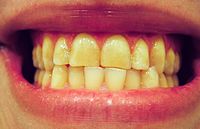
Photo from wikipedia
Background The purpose of the present study is to evaluate the prevalence of temporomandibular disorders (TMD) and their associated biological and psychological factors in Chinese university students. Methods A total… Click to show full abstract
Background The purpose of the present study is to evaluate the prevalence of temporomandibular disorders (TMD) and their associated biological and psychological factors in Chinese university students. Methods A total of 754 students were included from Zunyi Medical University, each participant completed questionnaires and clinical examinations according to the Diagnostic Criteria for Temporomandibular Disorders. Results The overall prevalence of TMD was 31.7% among medical students. Subjects with TMD had a high prevalence of bruxism, empty chewing, unilateral chewing, chewing gum, anterior teeth overbite, anterior teeth overjet, depression, anxiety, and sleep disturbance. Moreover, sleep bruxism, empty chewing, unilateral chewing, anterior teeth overbite, depression, and anxiety were the strongest risk factors for TMD. Conclusions Individuals with TMD have a high prevalence of psychological distress and oral parafunctional habits. Except for the psychological factors associated with TMD, bruxism, abnormal chewing, and malocclusion also shared similar risks for TMD.
Journal Title: BMC Oral Health
Year Published: 2021
Link to full text (if available)
Share on Social Media: Sign Up to like & get
recommendations!